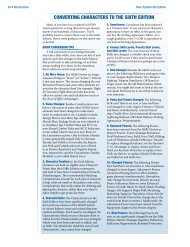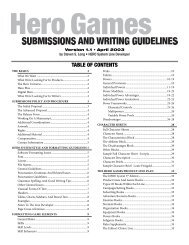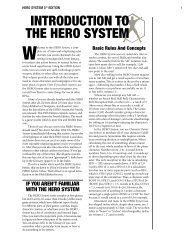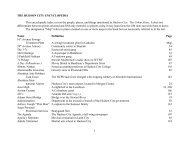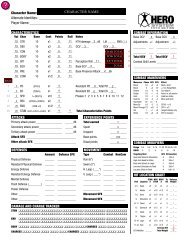Create successful ePaper yourself
Turn your PDF publications into a flip-book with our unique Google optimized e-Paper software.
Generally speaking, this reasoning extends to other powers, including Dispel (which is<br />
similar to Adjustment Powers in many ways), Flash, and the like. If the target cannot be affected<br />
by the power because he lacks what it targets (e.g., a blind person hit with a Sight Group Flash; a<br />
person without Flight hit with Dispel Flight), then the secondary effect (such as Does<br />
Knockback) also cannot apply. Note, however, that having a lot of defense against an attack (e.g.,<br />
enough Sight Group Flash Defense to totally block a Flash) or being temporarily immune to a<br />
power (e.g., a character being protected from Sight Group Flashes because he was just affected<br />
by one and is now temporarily blind) does not qualify as “cannot be affected” — as used above,<br />
that term generally means it’s impossible for the character ever to be affected, not just<br />
temporarily impossible.<br />
As always, the GM should apply these rules with an eye toward common sense, dramatic<br />
sense, special effects, and game balance.<br />
Page 147 — Impenetrable<br />
Q: If a character has some defenses that are Impenetrable and some that are not (as discussed on<br />
6E1 147), how do you determine whether Impenetrable “cancels out” Penetrating (and thus that<br />
the damage applies to the character normally), or the Penetrating attack has its standard<br />
(Advantaged) effect?<br />
A: If a character who has some Impenetrable defenses and some defenses that are not<br />
Impenetrable is hit with a Penetrating attack, compare the average BODY for the Penetrating<br />
attack to the Impenetrable defenses. (In the case of Drains and the like, count the “Normal<br />
Damage BODY” for these purposes, unless it’s a Drain BODY, in which case determine the<br />
average in the standard mathematical way.) If the average BODY exceeds the Impenetrable<br />
defenses, the Impenetrable is “overcome” and the Penetrating attack has its standard<br />
(Advantaged) effect. If the average BODY is less than or equal to the Impenetrable defenses, the<br />
Impenetrable “negates” the Penetrating and the attack applies to the target’s defenses in its<br />
standard (non-Advantaged) way.<br />
Example: Protector has 20 PD (non-Advantaged). He also has Resistant Protection (10<br />
PD/10 ED), Impenetrable. He’s hit with an RKA 2½d6, Penetrating bullet. The average<br />
BODY for that RKA would be 8.75 (2.5d6 x 3.5). That’s less than 10 PD, so Impenetrable<br />
applies and the Penetrating effect is negated.<br />
Later, Protector’s slashed with a magic sword (HKA 4d6, Penetrating). The average BODY on<br />
this attack is 14. That’s more than 10 PD, so the Impenetrable doesn’t apply; the attack has its<br />
usual Penetrating effect.<br />
Page 343 — Penetrating<br />
Q: If a character has some defenses that are Impenetrable and some that are not (as discussed on<br />
6E1 147), how do you determine whether Impenetrable “cancels out” Penetrating (and thus that<br />
the damage applies to the character normally), or the Penetrating attack has its standard



